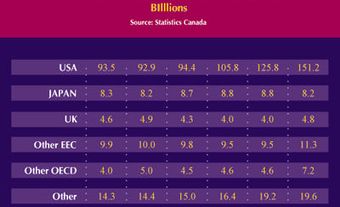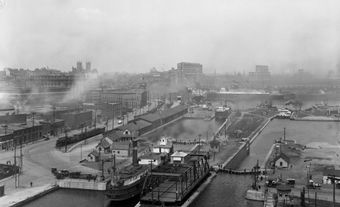Child labour is defined as the regular employment of boys and girls under the age of 15 or 16. Attitudes toward child labour have altered dramatically since the late 18th century, when it was generally assumed that children should contribute to the family economy from about age seven. By the beginning of the 20th century most Canadian provinces had enacted labour legislation to restrict the employment of children.

History
Prior to the 19th century, children were often seen as economic assets to families. In most cases, this meant assisting parents, but it could also entail paid employment outside the home. Such activities might include the acquisition of skills useful in adulthood, such as a formal apprenticeship. In Indigenous communities, in New France and in early English Canada, children contributed to daily tasks and to the family economy. However, during the 19th and early 20th centuries most Canadian children became economic liabilities to their families. Boys' and girls' time was increasingly taken up securing a formal education. By 1911 about 40 per cent of Canadian children aged five to nine, and 50 per cent of 10-to-19-year-olds were in school. As the percentage of children attending school increased, the proportion of boys aged 14-19 who were gainfully employed dropped from 68 per cent in 1921 to 40 per cent in 1961.
Industrialization and urbanization in the mid-19th century opened up more opportunities of paid employment for children who were not in school. The proportion of urban residents grew from about 17 per cent at Confederation in 1867 to over one-third by 1901, and to almost one-half by 1921. In major urban centres, children could find employment in Montreal textile mills, Hamilton businesses, mines in Cape Breton and British Columbia, and small manufacturing enterprises in the Maritimes. (See also Textile Industry; Mining.) Still, many jobs for children were considered "dead end" — poorly paid, menial positions without any opportunity for advancement. Some positions, such as those of messenger boy and newspaper vendor, did not lead to adult employment. Moreover, most children holding jobs came from working-class backgrounds.
Early Reform
Social reformers of this era were concerned with child labour and were intent on improving Canadian society. As well as supporting compulsory schooling and measures to combat juvenile delinquency, reformers sought to ban child labour. The first wave of provincial legislation regulating child labour in factories and mines began to pass in the 1870s and 1880s. But the prohibition of child labour did not come until the 20th century.
Several conditions combined to restrict and eventually end child labour in Canada. By the beginning of the 20th century most provinces had enacted labour laws to restrict the employment of children. Legislation restricting child employment in mines was enacted in Nova Scotia in 1873, and British Columbia in 1877. By 1929 children under 14 had been legally excluded from factory and mine employment in most provinces. (See also Industrialization in Canada; Mining.)
From the early 1870s to the mid-1920s all the provinces enacted legislation requiring school attendance. Sanctions were imposed on families that did not comply. In 1891, Ontario legislation required compulsory school attendance for eight-to-14-year-old children. In 1921, the Adolescent School Attendance Act increased the age of compulsory attendance in urban areas to 16. Following compulsory attendance, provinces gradually restricted child employment by the age of the child and by requiring students to pass through minimum grade levels. Although exemptions were common, legislation was designed so that compulsory education and labour restrictions were mutually supportive.
Depression and War
During the Great Depression, many adults sought jobs formerly done largely by children. During the Second World War, however, many children entered the workforce, defying school-attendance legislation. Since the war, it has been argued, women replaced children as part-time contributors to family income.
Child labour persisted into the 20th century in less visible forms. Between Confederation and the mid-1920s, about 80,000 British children, most under 14, were brought to Canada by humanitarian organizations wishing to give them a new start away from their working-class backgrounds. Most were apprenticed to rural families, and in general, became child labourers rather than adopted children. Growing sensitivity to their fate led to the prohibition of child immigration in 1925. (See also British Home Children.)
Conventions and Treaties
In 1926, the League of Nations established the Slavery Convention, a convention that defined slavery as "...the status or condition of a person over whom any or all of the powers attaching to the right of ownership are exercised....". (See also Canada and the League of Nations; Black Enslavement in Canada; Enslavement of Indigenous People in Canada.) By 1930 the convention was broadened by the International Labour Organization (ILO) to specifically define forced labour. The ILO’s Forced Labour Convention, 1930 (No. 29), supplemented the convention to include the abolition of slavery, the slave trade, and institutions and practices similar to slavery or forced labour. Canada helped develop Convention No. 29, but the country only ratified the convention in 2011. In 1959 Canada ratified the ILO’s Abolition of Forced Labour Convention, 1957 (No. 105), which specifically prohibits forced or compulsory labour as a means of political coercion.
In 2000 Canada ratified the ILO’s Worst Forms of Child Labour Convention, 1999 (No. 182), which opposes the worst forms of child labour such as trafficking, recruitment of child soldiers and prostitution. As of 2016, Canada ratified the ILO’s Minimum Age Convention, 1973 (No. 138), which aims to establish a minimum age for working children.
Legacy
Today in Canada, work outside school hours is generally allowed. However, for children under 16, school attendance is compulsory and employment is restricted. The legislation governing minimum age, number of working hours per day and the time of day that a youth may work varies between the provinces and territories. Some provinces require parental permission for a minor to be employed. For example, in Quebec, an employer must obtain written permission from a parent or guardian to employ a child under the age of 14. Legislation also exists to protect minors from working under dangerous or hazardous conditions, such as in the mining industry, manufacturing, construction, forestry, and where liquor is sold or kept for sale.

 Share on Facebook
Share on Facebook Share on X
Share on X Share by Email
Share by Email Share on Google Classroom
Share on Google Classroom






